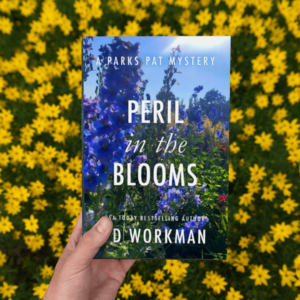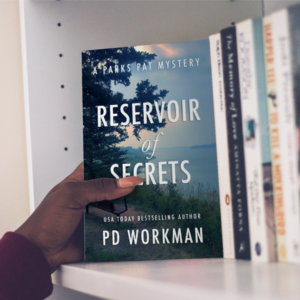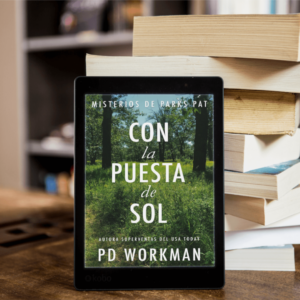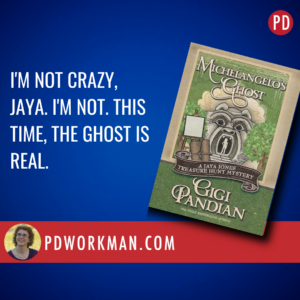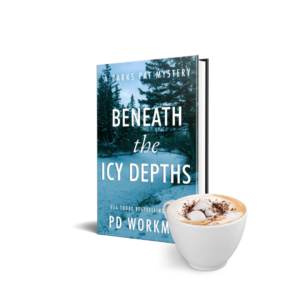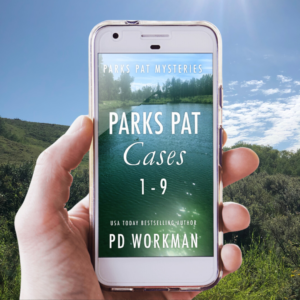
World Day for Cultural Awareness is celebrated on May 21 every year, providing an opportunity to promote cultural diversity and understanding. In today’s world, where people are increasingly isolated and divided, it is important to celebrate our differences and learn from each other. As an author, I strive to incorporate diverse perspectives and cultures into my writing, promoting empathy and understanding among readers.
Incorporating diverse perspectives and cultures into literature is crucial for promoting empathy and understanding. Through my Parks Pat Mysteries series, I aim to showcase the importance of cultural awareness and empathy in literature. The series provides readers with a thrilling read while also offering glimpses into Canada’s Indigenous culture.
My Parks Pat Mysteries series is set in beautiful parks in and around Calgary, following Detective Margie Patenaude as she investigates a string of murders while juggling the challenges of being a single mom and Métis woman. With each case, Margie and her team investigate a murder in a different park in Calgary, providing vivid descriptions of the city’s natural beauty. The mysteries are intricate and fast-paced, and readers will love the well-developed characters and situations that are believable. There are currently six books out, with three more being released next month (including Sanctuary in the Stream, which will be my 100th published book!)
The series has received praise from readers, commenting on the excellent writing, twisty plots, and interesting glimpses into Canada’s Indigenous culture. The books are quick reads, making them perfect for those days when readers need a break from their busy lives. As an author, I believe that reading diverse books can help promote understanding and empathy.
World Day for Cultural Awareness is a reminder to celebrate diversity and learn from each other. I hope that the Parks Pat Mysteries series can promote cultural understanding and provide a thrilling read at the same time. Pick up a copy of the series and take a walk in a Calgary park with Parks Pat today!
Parks Pat Cases 1-6
Looking for a gripping police procedural series set in the stunning parks of Calgary?
Look no further than the Parks Pat Mysteries by P.D. Workman. Follow Detective Margie Patenaude as she investigates a string of murders in the city’s parks, all while juggling the challenges of being a single mom and Métis woman.
Readers will love the fast-paced action, intricate mysteries, and vivid descriptions of Calgary’s natural beauty. With each case, you’ll be transported to a new park, keeping you on the edge of your seat until the very end.
⭐️⭐️⭐️⭐️⭐️ The writing is excellent, the plot is nice and twisty and the the characters and situations are believable. I enjoyed this book and am looking forward to seeing where she takes these new characters.
⭐️⭐️⭐️⭐️⭐️ This is another well-written, briskly-paced mystery featuring great characters, lots of interesting glimpses into Canada’s Indigenous culture, and a satisfying resolution all wrapped up in delightful quick-read police procedural by an author who could make a description of drying paint sound fascinating.
Whether you’re a fan of police procedurals, Canadian mysteries, or just looking for a thrilling read, the Parks Pat Mysteries are sure to satisfy. Don’t miss out on this exciting new series — grab your copy today!
These short mysteries are just right for those days when you could use a break from your busy life.
Take a walk in a Calgary park with Parks Pat.
This collection includes cases 1-6

Margie Patenaude is new in town and wasn’t expecting to get called to a murder scene on her daughter’s first day of school.
It’s an ugly murder in a beautiful setting. How can Calgary’s park-goers feel safe with a murderer still on the streets—or pathways? Margie and the team are on the case while at the same time she and her daughter try to acclimatize to the new city.
Detective Pat is called out to another park homicide scene with disturbing similarities to the Fish Creek murder. Digging more deeply into the evidence reveals something even more worrisome. If her instincts are right, this case may hit a little too close to home.
Detective “Parks” Pat has made a name for herself in solving the Fish Creek and Glenbow Ranch murders, so she is the one they call when a body turns up in Ralph Klein Park. She would be happy for the confidence placed in her if it weren’t for the fact that the body is in the water.
Detective “Parks” Pat is back. Now an established and accepted member of the homicide squad, she unexpectedly brings a new case to the table when she stumbles across a body as Canada Day dawns. While it was initially assumed to be an accidental drowning, the autopsy results say otherwise.
It’s Parade Day, and Margie would have thought that any trouble would have centered around drinking and motor vehicles. Or being trampled by horses. Or clowns. But the latest homicide investigation is nowhere near the parade route, but on the outskirts of town. And the culprit appears to be a tiny boat.
A woman is found at the bottom of a 70-meter drop. It is pretty clear from the beginning that she was killed in the fall.
But you can never be sure until the medical examiner’s report comes back. It would appear that there is a lot more to be investigated after all.
COMING SOON!
Three more books in the series are available for preorder. Don’t miss Knows the Hills, Spanning the Creek, and Sanctuary in the Stream.
Investigate this new series today!
AND MORE
In addition to my Parks Pat Mysteries series, many other books can provide insight into different cultures and perspectives.
Spines and Slaughter is set it Peru and focuses on the Quechua people there.
Spines and Slaughter
Sometimes the demons of stories take on human faces.
When Poe Baxter and her friend Beattie travel to Lima, Peru, to hunt down a rare collection of Peruvian folktales, the two women find themselves mixed up in a game of deceit that echoes the legend of the chullachaqui. Soon, they’re having trouble telling truth from lie, even when their lives are at stake.
Can Poe and Beattie discern what is real from what is myth before it’s too late?

Americanah by Chimamanda Ngozi Adichie explores the experiences of a Nigerian woman living in the United States, while The Kite Runner by Khaled Hosseini provides a glimpse into life in Afghanistan. The Joy Luck Club by Amy Tan explores the experiences of Chinese-American women and their relationships with their mothers.
Americanah
Ifemelu and Obinze are young and in love when they depart military-ruled Nigeria for the West. Beautiful, self-assured Ifemelu heads for America, where despite her academic success, she is forced to grapple with what it means to be black for the first time.
Quiet, thoughtful Obinze had hoped to join her, but with post-9/11 America closed to him, he instead plunges into a dangerous, undocumented life in London. Fifteen years later, they reunite in a newly democratic Nigeria, and reignite their passion—for each other and for their homeland.

The Kite Runner
1970s Afghanistan: Twelve-year-old Amir is desperate to win the local kite-fighting tournament and his loyal friend Hassan promises to help him. But neither of the boys can foresee what would happen to Hassan that afternoon, an event that is to shatter their lives. After the Russians invade and the family is forced to flee to America, Amir realises that one day he must return to an Afghanistan under Taliban rule to find the one thing that his new world cannot grant him: redemption.

The Joy Luck Club
Four mothers, four daughters, four families, whose histories shift with the four winds depending on who’s telling the stories. In 1949, four Chinese women, recent immigrants to San Francisco, meet weekly to play mahjong and tell stories of what they left behind in China. United in loss and new hope for their daughters’ futures, they call themselves the Joy Luck Club. Their daughters, who have never heard these stories, think their mothers’ advice is irrelevant to their modern American lives – until their own inner crises reveal how much they’ve unknowingly inherited of their mothers’ pasts.
With wit and sensitivity, Amy Tan examines the sometimes painful, often tender, and always deep connection between mothers and daughters. As each woman reveals her secrets, trying to unravel the truth about her life, the strings become more tangled, more entwined. Mothers boast or despair over daughters, and daughters roll their eyes even as they feel the inextricable tightening of their matriarchal ties. Tan is an astute storyteller, enticing readers to immerse themselves into these lives of complexity and mystery.

Other books that can promote cultural awareness include The Namesake by Jhumpa Lahiri, which explores the experiences of an Indian-American family, and The Color Purple by Alice Walker, which provides a powerful portrayal of the experiences of African-American women in the South. The God of Small Things by Arundhati Roy is another great book that explores the experiences of a family in India.
The Namesake
Jhumpa Lahiri’s Interpreter of Maladies established this young writer as one the most brilliant of her generation. Her stories are one of the very few debut works — and only a handful of collections — to have won the Pulitzer Prize for fiction. Among the many other awards and honors it received were the New Yorker Debut of the Year award, the PEN/Hemingway Award, and the highest critical praise for its grace, acuity, and compassion in detailing lives transported from India to America.
In The Namesake, Lahiri enriches the themes that made her collection an international bestseller: the immigrant experience, the clash of cultures, the conflicts of assimilation, and, most poignantly, the tangled ties between generations. Here again Lahiri displays her deft touch for the perfect detail — the fleeting moment, the turn of phrase — that opens whole worlds of emotion.
The Namesake takes the Ganguli family from their tradition-bound life in Calcutta through their fraught transformation into Americans. On the heels of their arranged wedding, Ashoke and Ashima Ganguli settle together in Cambridge, Massachusetts. An engineer by training, Ashoke adapts far less warily than his wife, who resists all things American and pines for her family. When their son is born, the task of naming him betrays the vexed results of bringing old ways to the new world. Named for a Russian writer by his Indian parents in memory of a catastrophe years before, Gogol Ganguli knows only that he suffers the burden of his heritage as well as his odd, antic name.
Lahiri brings great empathy to Gogol as he stumbles along the first-generation path, strewn with conflicting loyalties, comic detours, and wrenching love affairs. With penetrating insight, she reveals not only the defining power of the names and expectations bestowed upon us by our parents, but also the means by which we slowly, sometimes painfully, come to define ourselves.

The Color Purple
A powerful cultural touchstone of modern American literature, The Color Purple depicts the lives of African American women in early twentieth-century rural Georgia. Separated as girls, sisters Celie and Nettie sustain their loyalty to and hope in each other across time, distance and silence. Through a series of letters spanning twenty years, first from Celie to God, then the sisters to each other despite the unknown, the novel draws readers into its rich and memorable portrayals of Celie, Nettie, Shug Avery and Sofia and their experience. The Color Purple broke the silence around domestic and sexual abuse, narrating the lives of women through their pain and struggle, companionship and growth, resilience and bravery. Deeply compassionate and beautifully imagined, Alice Walker’s epic carries readers on a spirit-affirming journey towards redemption and love.

The God of Small Things
The year is 1969. In the state of Kerala, on the southernmost tip of India, a skyblue Plymouth with chrome tailfins is stranded on the highway amid a Marxist workers’ demonstration. Inside the car sit two-egg twins Rahel and Esthappen, and so begins their tale. . . .
Armed only with the invincible innocence of children, they fashion a childhood for themselves in the shade of the wreck that is their family—their lonely, lovely mother, Ammu (who loves by night the man her children love by day), their blind grandmother, Mammachi (who plays Handel on her violin), their beloved uncle Chacko (Rhodes scholar, pickle baron, radical Marxist, bottom-pincher), their enemy, Baby Kochamma (ex-nun and incumbent grandaunt), and the ghost of an imperial entomologist’s moth (with unusually dense dorsal tufts).
When their English cousin, Sophie Mol, and her mother, Margaret Kochamma, arrive on a Christmas visit, Esthappen and Rahel learn that Things Can Change in a Day. That lives can twist into new, ugly shapes, even cease forever, beside their river “graygreen.” With fish in it. With the sky and trees in it. And at night, the broken yellow moon in it.
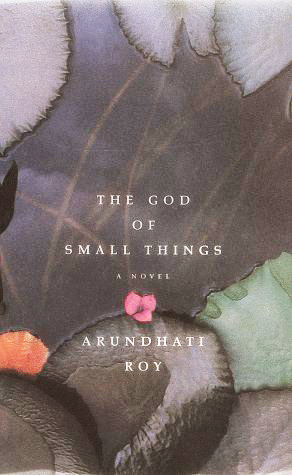
On World Day for Cultural Awareness, let’s celebrate diversity and learn from each other by exploring different cultures through literature. Reading diverse books is a great start, but don’t stop there. Participate in cultural events and activities in your local community to actively promote cultural awareness and make a positive impact. By working together, we can create a more diverse and inclusive world. Let’s take the time to appreciate the beauty of diversity and learn from each other. Whether it’s through literature, cultural events, or simply having conversations with people from different backgrounds, we can work towards creating a more inclusive and harmonious society.











